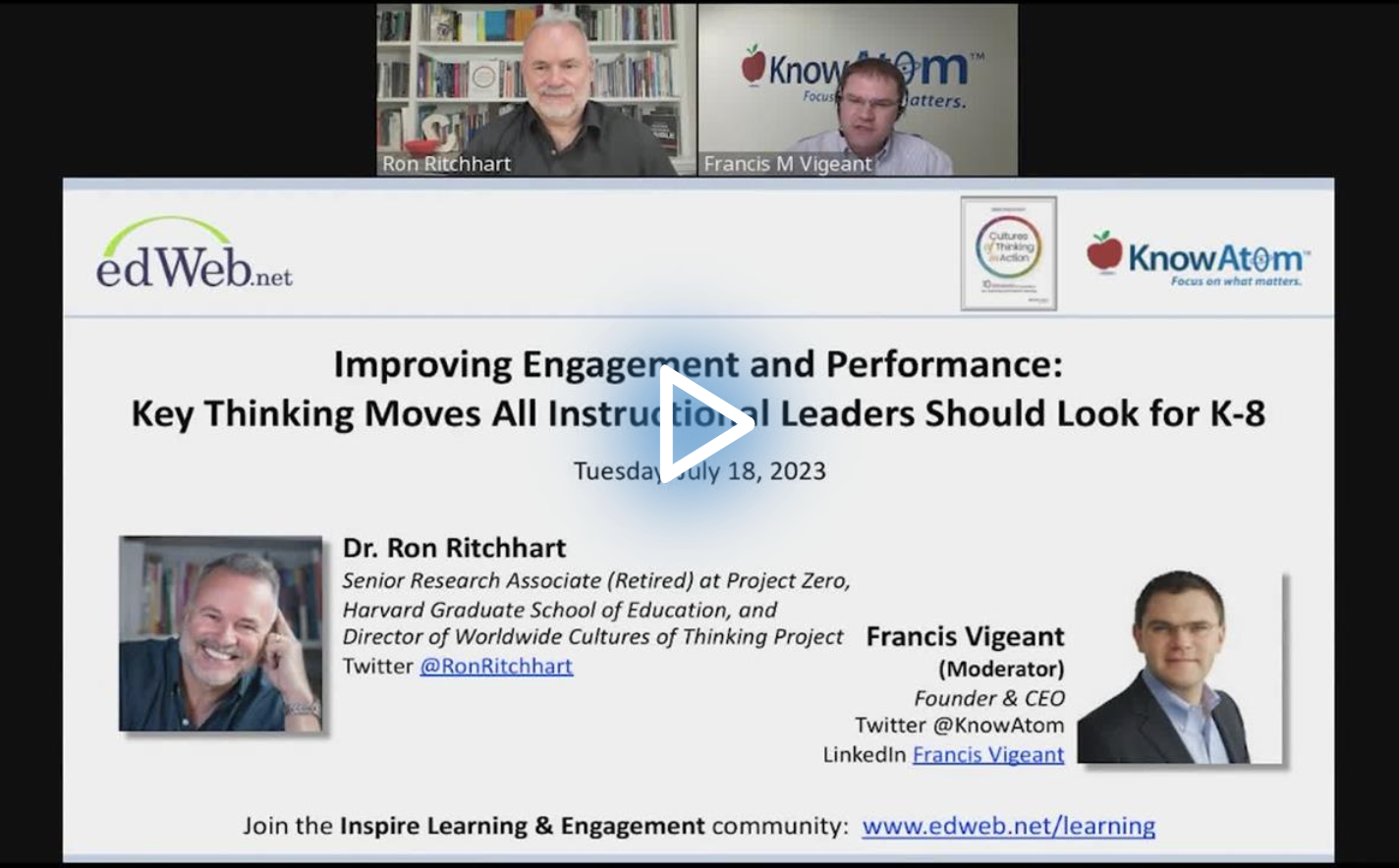Rethinking How We Ask Students to Think in the Classroom
Watch the Recording Listen to the Podcast
Typical conversations about education reform revolve around things like how we teach (education policy) or what we teach (the curriculum). But according to Dr. Ron Ritchhart, world-renowned educator, researcher, and author, and Francis Vigeant, KnowAtom’s Founder and CEO, changing the “what” and “how” in education doesn’t have nearly as much impact as looking at the “why.”
In the edLeader Panel “Improving Engagement and Performance: Key Thinking Moves All Instructional Leaders Should Look for K-8,” Dr. Ritchhart and Vigeant explained that teachers who evaluate why they teach what they teach will make more informed decisions that lead to deeper student learning.
First, they challenged the audience to examine how the status quo in education actually works.
- Transmission-style teaching: Students become dependent on a textbook, teacher, or app to tell them what they should know.
- Focus on short-term performance: Teach the students some information, give them a test, see the results, and call it learning. While this is good for the test at the moment, it doesn’t work for long-term learning.
- Emphasis on reproducing results: When students are given a task or project, the goal is for all of them to replicate the teachers’ results—or each other’s—to show they have learned something with little independent inquiry.
- Simplified learning: Teachers often assume students need their subject matter made easier or “fun” so that they can understand it and don’t challenge them to look beyond what the teacher presents.
- Concentration on review: Questions in the classroom often ask students to repeat what they’ve learned before and don’t extend beyond the curricular material.
What all of these have in common is that the students aren’t being challenged to think for themselves. They are repeating and reciting information, but they aren’t internalizing it and understanding how what they’re learning connects together.
Instead, the panelists advocated for teachers to create a culture of thinking, where teachers are as invested in creating educational curiosity.
Embrace Challenges
For students to have a deeper understanding, they need tasks that reflect that goal. They don’t need to start at lower-level tasks because the tasks targeted at the upper levels will teach the lower-level skills as well.
The idea is to have students struggle productively. Give them a chance to get stuck, figure out why they are stuck, and unstick themselves. If a teacher’s why is to just complete the task, then the instructional focus is on completion. Effective teachers understand that it’s in the grappling where the learning will happen.
Inspire Curiosity and Creativity
Rather than approaching a lesson with a set outcome and expected answers from students, think about how the students can explore a topic. What do they know? What do they want to know? What experiences have they had? The teacher can model their own curiosity as well. Then, create activities for the students that allow them to dig deeper into these questions.
Show a Genuine Interest in Student Thinking
Instead of questions motivated by reviewing content for an assessment, ask constructive questions that let students demonstrate their thinking. Let them share how they are making connections between concepts. When student thinking is made visible and supported, it can lead to greater engagement and deeper learning and understanding of the concepts.
Let Students Guide the Lessons
While there are concepts teachers need to emphasize, every lesson shouldn’t just be making students curious about what you want to teach. Think about how to create situations where you work on what students are curious about as related to the subject. Talk about real-world situations that impact their lives and help them make connections between their schoolwork and home.
Ultimately, the goal is to create a culture of thinking where students and teachers are investigating concepts and making connections. While teachers want their students to become more engaged in the classroom, switching to this method makes teachers feel nervous about not covering all of the content.
Dr. Ritchhart encouraged teachers to change their own thinking. Instead of sprinkling the content over the students over the course of the semester, think about providing magnets of deep understanding which will allow students to connect the smaller bits of knowledge.
Learn more about this edWeb broadcast, “Improving Engagement and Performance: Key Thinking Moves All Instructional Leaders Should Look for K-8,” co-sponsored by KnowAtom & Worldwide Cultures of Thinking in Action.
Watch the Recording Listen to the Podcast
Join the Community
Inspire Learning & Engagement is a free professional learning community where you’ll connect with educators who, like you, are searching for new ways to ignite and inspire learning and engagement.
More than 17 years ago, we started KnowAtom because… Teachers are important. They nurture student creativity and shape the next generation of problem solvers. But all teachers achieve more with complete resources and support. That’s where we come in. As teachers ourselves, we believe creative, evaluative, and analytical thinking skills prepare all students for any college or career choice. And STEM disciplines are the perfect venue for learning these skills hands-on. With KnowAtom, students are scientists and engineers. They investigate real-world phenomena and learn how to solve problems and answer questions for themselves. KnowAtom provides schools with K-8 curriculum and materials designed for the Next Generation Science Standards. Plus you’ll never have to shop for materials again — we deliver all the hands-on resources you need right to your classroom. So what are you waiting for? We’re here to help. Learn More About KnowAtom.
The Worldwide Cultures of Thinking Project began with two frameworks. The first was the 8 Cultural Forces, a framework that helps to illuminate the building blocks of group culture. The second was the framework, in the form of the Understanding Map, for understanding what we mean by thinking. These frameworks, and the associated tools we have developed around them, are important vehicles for teachers and schools to leverage as they embark on creating robust cultures of thinking.
Our current research in the Worldwide Cultures of Thinking Project has focused on identifying these mindsets/stances. They represent 10 guiding principles that propel the development of a culture of thinking. Thus, we call this current line of research, Cultures of Thinking in Action. We present these principles along with an accompanying theory of action that ties actions to outcomes. We also present a collection of resources, tools, actions, and practices.
Blog post by Stacey Pusey, based on this edLeader Panel.








Comments are closed.